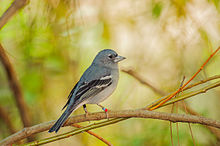| Gran Canaria blue chaffinch | |
|---|---|
 | |
| Male | |
| Scientific classification | |
| Domain: | Eukaryota |
| Kingdom: | Animalia |
| Phylum: | Chordata |
| Class: | Aves |
| Order: | Passeriformes |
| Family: | Fringillidae |
| Subfamily: | Fringillinae |
| Genus: | Fringilla |
| Species: | F. polatzeki |
| Binomial name | |
| Fringilla polatzeki Hartert, 1905 | |
| Synonyms | |
Fringilla teydea polatzeki Hartert, 1905 | |
The Gran Canaria blue chaffinch (Fringilla polatzeki) is a species of passerine bird in the finch family Fringillidae. It is endemic to Gran Canaria in Spain's Canary Islands.



